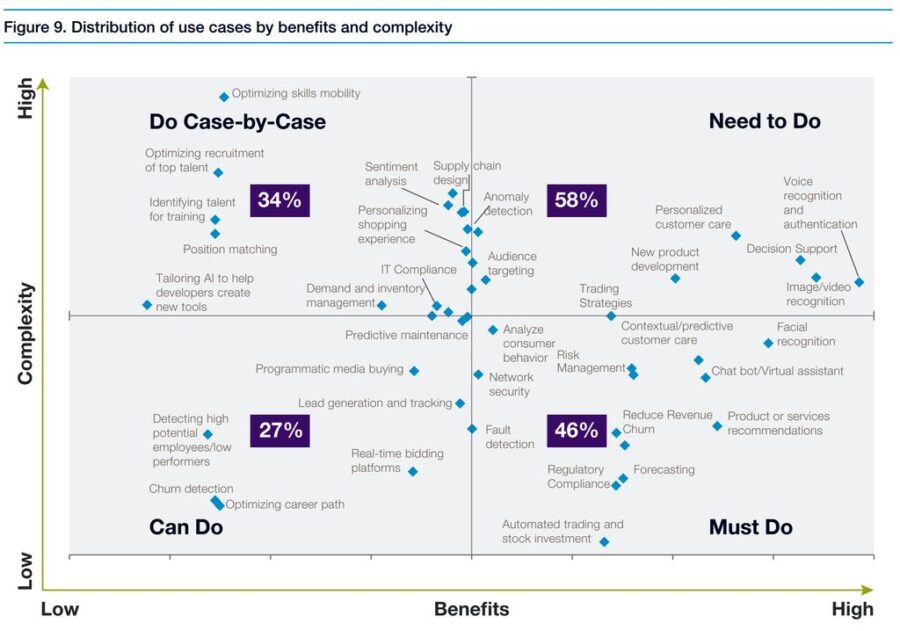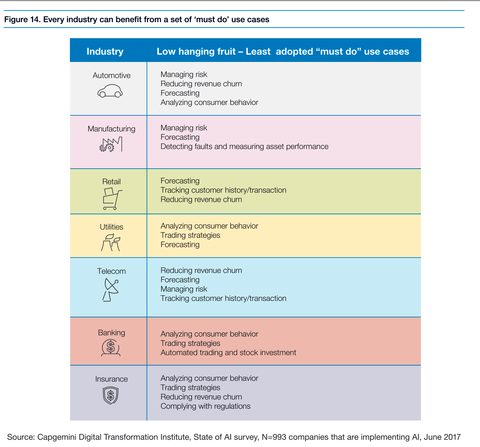Summary: Even if you’re not big enough to have a full blown data science group that shouldn’t hold you back from benefiting from AI. The market has evolved so that there are now industry and process specific vertical applications available from 3rd party AI vendors that you can implement. There are just a few things to look out for.
 Now that we are squarely in the midst of the exploitation phase of AI, pretty much everything you read will exhort you to hire a bunch of data scientists and get busy. This is not to make light of the top level commitment and organizational effort that’s necessary to establish an Advanced Analytics and AI Center of Excellence in your company. It’s just not the right approach for everyone.
Now that we are squarely in the midst of the exploitation phase of AI, pretty much everything you read will exhort you to hire a bunch of data scientists and get busy. This is not to make light of the top level commitment and organizational effort that’s necessary to establish an Advanced Analytics and AI Center of Excellence in your company. It’s just not the right approach for everyone.
If you’re not a member of that elite BIG COMPANY crowd, if you don’t think you can support a full court press, or if you just haven’t gotten around to starting what we’re calling ‘your digital journey’, there are still plenty of ways to get started and benefit from AI.
In fact a recent Capgemini study shows that only about 1/5th to 1/3rd of businesses (depending on industry) are implementing AI ‘at scale’, meaning that they’re putting on a corporate-wide effort for maximum rapid adoption (based on a pretty comprehensive survey of 993 companies in June 2017).
So are the balance of about 75% of companies just getting left behind? No, and if you haven’t dived into this, neither should you.
Getting Started Cautiously
There are a lot of good reasons for getting into AI with some caution including:
- You think it overhyped – at least a little true.
- You think the costs are likely to be too high – but the benefits are high too.
- You don’t have enough/any data scientists on board to help – you’re better off having at least a few to guide you.
- Your top executives haven’t gotten around to making this a priority – well that one’s on you.
And in fact implementing AI across an entire enterprise is just too much ocean to boil for most folks. So the question is how to rationally ease in and start to benefit before your competitors show you that you’re too late.
So What’s Changed?
Well just over the last year or two, the number of vendors offering vertical specific applications suited for your industry has really exploded. And separately the number of consulting companies claiming AI implementation expertise has also grown remarkably.
Up until only recently the great majority of advanced analytic and AI solutions were custom developed by an in-house team of data scientists and data engineers. You could hire-in some consulting data scientists to up-skill your team, but in the end it was custom development and all that implies.
Today there are a reasonable number of AI applications targeting processes in your industry that you can, with some care, find a qualified vendor who will install, maintain, and continuously upgrade your AI app.
Where to Start – With the Proverbial Low Hanging Fruit
It remains true that the best starting point is always a company-wide digital strategy. We’ve written recently about how this should result in a Portfolio of AI Improvement Projects that is both comprehensive and at the same time simply enough stated that top execs can easily prioritize implementation.
But if you don’t have the time, the corporate support, or the energy for this, there are now enough fully proven use cases that you should be able to select one that promises high reward and least risk, the very definition of low hanging fruit.
Capgemini starts by arranging this along the dimensions of benefits versus complexity (risk) and offers this analysis of common use cases breaking them down by Must Do, Can Do, Need to Do (higher risk), and Do Case by Case (low benefit, higher risk). 
There is another interesting lesson in this chart. The percentages shown in each quadrant are the percentage of their survey respondents executing a project in each category. A surprisingly high percentage has a project in the high benefit/high risk quadrant. These are primarily the roughly 25% of companies putting on the company-wide full court press. You will want to focus on the Must Do opportunities providing high payoff with least risk.
By industry, the top opportunities identified by Capgemini, also representing low hanging fruit are these:

Start by Reimagining Your Major Processes
Identifying an appropriate AI target is not much different from any other sort of improvement project. You need to start by first identify a process in need of improvement, envision how the process can change with this new capability, and layout your expectations in some detail of the benefits you expect and the investment that will justify.
These can run the gamut from simple cost reduction to completely reimagined highly automated processes.
For example, implementing a chatbot to supplement your CSRs response to customer inquiries, problems, and even order taking can dramatically reduce cost and improve customer satisfaction. The design and implementation of chatbots is well understood and relatively low complexity.
On the other hand, a more ambitious project for which the AI technique is still relatively low complexity illustrates how AI can completely change your business process. The example is how some players in the auto insurance industry are utilizing image-based AI evaluation and estimation of auto damage to dramatically reduce total cycle time, cost, and increase customer satisfaction.
In this newly envisioned AI enabled process, when a customer has an accident, they push a button on a phone app that immediately notifies the insurer that an accident has occurred. In at least some instances, this single action also summons an Uber driver to take the customer home, and either the customer or Uber driver (depending on the company) takes pictures of the damage that are evaluated for cost by AI in real time, and checked and verified when necessary by a claim adjuster. By the time a tow truck arrives, the insurer has already determined the value of the repair, selected a repair agency, and can direct the tow directly to the repair center.
Does the Solution Have to be AI?
Once you’ve identified the target problem and done your homework on vendors offering vertical solutions, an initial step will always be to understand the basis for their proposed solution. Here it will definitely help to have at least one senior in-house data scientist assigned to the team to help evaluate the quality of the proposed solution.
Should you be concerned if the proposed solution is not technically AI, but based on traditional machine learning? Probably not at all. In fact, ML solutions are extremely well understood and the additional value added by solving the same problem with an AI technique may be small and easily offset by a reduction in complexity based risk. In general, you will probably want to start with ML solutions and save AI solutions for later in your digital journey.
A Few Ways that Advanced Analytics / AI Projects are Different from Other Types of Improvement Projects
- ML/AI techniques all require both training data and a flow of clean data from your systems to be initialized and to operate. There is no such thing as a turnkey plug-and-play ML/AI application.
- All ML/AI models rely on ‘clean’ data. The level of effort to clean the data flowing from your existing systems will be determined during implementation. You need to plan for the required IT or data engineering staff to maintain this.
- The model(s) embedded in your new process need to be refreshed periodically with new training data. You need to understand how your vendor determines how often this must occur, whether they will provide this service, or whether you need to hire data science and engineering staff to maintain the new tool.
- A successful implementation will take equal parts industry/domain knowledge and data science expertise. Your selected vendor should be able to demonstrate that they have a deep understanding of your industry and business. You should also be prepared to provide some SME and data science in-house personnel to help or supervise the project.
- Your vendor should provide a detailed plan for how the implemented system will be tested before it’s exposed to real customers or live business situations.
- If this is your first effort in AI/ML you will rapidly realize that you need to establish some sort of higher level governance and oversight activity to provide guidance, resources, and planning for this and your future efforts.
Whatever You Do, Get Started Now
Picking target processes isn’t difficult. Many of them will be customer facing to improve customer experience, but you’ll also find good opportunities in activities like forecasting, or even back office activities like managing receivables or working capital, or sending bills out. The key is to start.
Other articles by Bill Vorhies.
About the author: Bill Vorhies is Editorial Director for Data Science Central and has practiced as a data scientist since 2001. He can be reached at:
[email protected] or [email protected]
